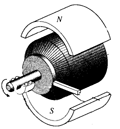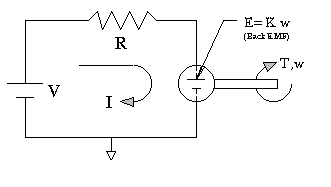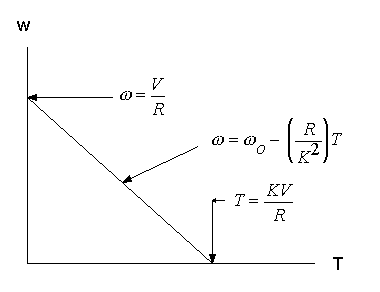

Types of Motors
The Theory of Permanent Magnet DC Motors
Characterizing Motors in Practice
Places to find motors
Common Problems when using Motors
References
| Type | Advantages | Disadvantages |
| Stepper Motor | Very precise speed and postion control. High Torque at low speed | Expensive and hard to find. Require a switching control circuit |
| DC Motor w/field coil | Wide range of speeds and torques. More powerful than permanent magnet motors | Require more current than permanent magnet motors, since field coil must be energized. Generally heavier than permanent magnet motors. More difficult to obtain. |
| DC permanent magnet motor | Small, compact, and easy to find. Very inexpensive | Generally small. Cannot vary magnetic field strength. |
| Gasoline (small two stroke) |
Very high power/weight ratio. Provide Extremely high torque. No batteries required | Expensive, loud, difficult to mount, very high vibration. |
Because permanent magnet motors are so commonly used, the rest of this section will be dedicated to their operation and application.








| Supplier | Selection | Types of Motors Available |
| Radio Shack | Good | Small motors from 3-12V. Most are less than $10. |
| Hobby Stores | Good | 9-18V motors- Most made to run on multi-cell rechargeable battery packs. Most are $20-$40. Generally pretty powerful motors. |
| Electric Screwdrivers | Fair | Very compact, high torque motors. Recharger, batteries, etc, are all included. Also has a planetary gear train too. Most are $20-$30. |
| Vendor Catalogs | Excellent | Many different available. Must normally wait for shipping and handling, and sometimes there is a minimum order. See www links for a URL's of some vendors to get free catalogs.. |
| Toy Stores | Poor | Motors available in various, small motorized toys. These motors normally very small, and run on 3V or 6V at the most.. |
 Problem:
Problem:Our motor doesn't have enough power to perform the necessary task in our machine, but we have already bought the motor: what can we do?
 Solution:
Solution:From a conservation of energy standpoint, if you don't have enough energy out of the system, add more into the system. In other words, increase the size of your batteries. If you add more batteries in series with the ones you already have, you will give the motor a higher top speed. On the other hand, if you need more torque, you can add more batteries in parallel with the existing ones, and your batteries will provide more torque at the same voltage. This is the way to go if your batteries are already supplying the rated voltage to the motor. Another obvious solution is to reduce the load on the motor.
The final, and most commonly implemented solution to this problem is to use a gear train to gear your motor down or up. You can gain torque or speed at the expense of the other. (See Gears).
 Problem:
Problem:Our machine works ok, but it drains the batteries very quickly. Batteries are getting expensive! What do we do?
 Solution:
Solution:Batteries are rated for a certain number of amp-hours. Alkaline batteries will typically have a larger rating than rechargables, for example. An amp-hour rating of 9 means that the battery can supply 1 amp for 9 hours, or 9 amps for 1-hour, or anywhere in between. If you know the characteristics of your motor (see the motor specifications section), you can calculate the current that your motor is drawing, and from the amp-hour rating of your batteries, you know how long they will last. Because it is more of an issue with rechargables, they are more likely to supply this information when you purchase them.
There are two solutions to this problem: reduce the load on the motor so that it draws less current, or get more batteries so that your battery pack can supply the same amount of current longer. Keep in mind that adding a gear train will in general NOT cure this problem, since the amount of power that is consumed by the motor will be the same. If your machine was alreading moving forward, adding a gear train will reduce the torque load on the motor, but the vehicle will move faster, and the motor will end up consuming the same amount of power. (Actually, the gear train will have some losses, and you might actually make the problem worse!)
 Problem:
Problem:We are still in the design phase, and have no good idea how big of a motor we need to buy, or how big the batteries should be. What is a good way to figure this out?
 Solution:
Solution:The answer to this very common problem is not trivial- that's why it's a common problem. The following steps might help you make a good guess:
- Gather the most complete and specific information you can about the task that the motor will need to perform. For example, get a good guess at the size of the machine, the angle of the incline it will need to climb, the amount of time it will run, the torque the motor will need to provide. If you can't quantify the applicable variables, then make a conservative 'best guess'.
- Use the information gathered in (1) and physical relations to calculate the power that will be necessary, the torque that will be necessary, the time required, or whatever items are applicable.
- Compare the information calculated in (2) to available motors and batteries. Start by finding the power you need, and then choose a voltage that is commonly available. Then use conservation of energy and the power equation in the theory section to calculate how much current the motor might draw at this voltage. Finally, multiply this current by the time of operation and find the rating of the battery that might be required.
WWW links
Stock Drive Products Free design guides and a
large number of mechanical components available here
Boston Gear Division Another gear
Vendor
AutoMationNET
List of several vendors for a comprehensive list of mechanical components.
List of Mechanical Engineering
Vendors




